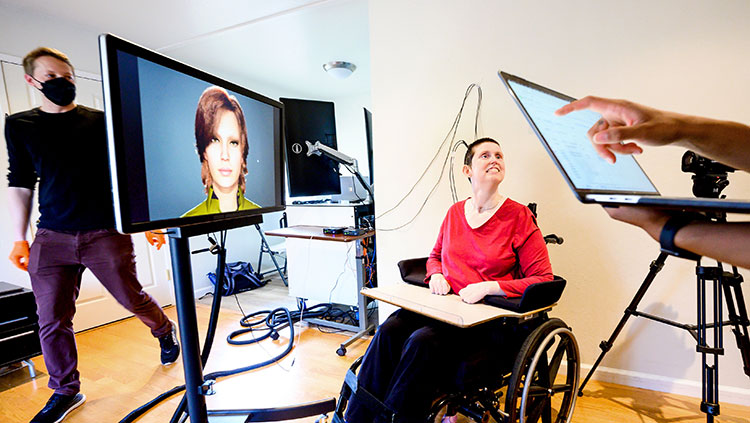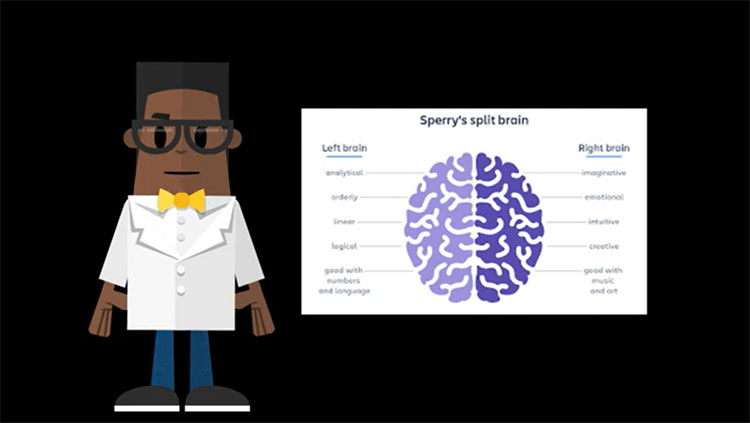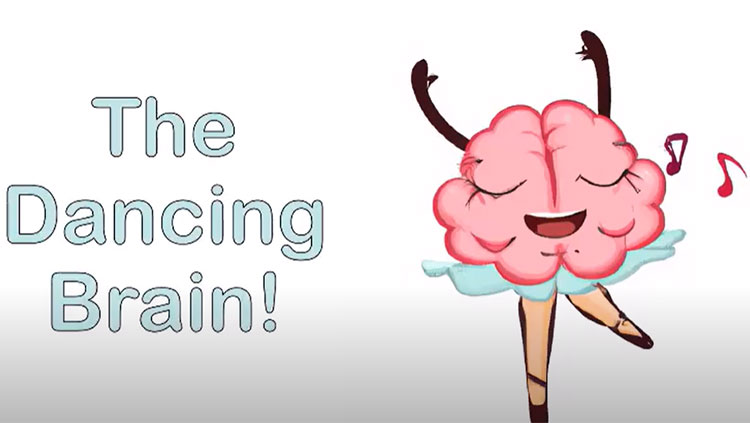Why does the brain look so weird? The appearance of the body’s organs often reflects their function. The heart resembles a pump, and the kidneys and liver look a bit like filters. But at first blush, the appearance of the brain bears little relationship to what it actually does. While we now know it to be an organ of thought, the philosopher Aristotle once supposed that it was only a glorified radiator. I've held a human brain in my hands many times. You might think for a neuroscientist that this would be a completely routine thing – it isn't. My opportunities to do this have usually been in the context of science communication where I might quickly point out features of the brain to students and describe each with a little shorthand that conveys a general sense of how the regions of the brain map to certain functions.
Kids for whom I’ve done this are usually awestruck. There’s something exciting about being confronted with something each of us possess, but can never observe. Most have never seen a brain before, and their experience with death is usually very different than what I’m holding in my hand. I can’t help but marvel at the convolutions of the brain – of this brain. In its tortious anatomy are the etchings that mark a life. Now lifeless and stiffened by preservatives to the look and feel of clay, it was once vibrant - as supple and soft as tofu, pulsing with blood and humming with electrical activity as thoughts bounced around circuits that experienced decades of learning and loving – maybe even holding brains. Embedded in the gyri (the bumps) and sulci (the grooves) is a developmental marvel that is the product of millions of years of adaptation, with an expansion in recent human evolution creating these wrinkles that are common in human brains but are by no means exclusive to us. For example, dogs, cats, monkeys, elephants and whales all have this feature. How much are my brain wrinkles like yours?
When you see two computers side by side, it’s the result of a manufacturing process that has generated copies that are nearly identical. But brains aren’t manufactured – they’re grown. Just as you wouldn’t expect two tomatoes to be identical, neither are brains. Watering a tomato plant or feeding it a different amount of fertilizer will affect its growth. Likewise, the brain is exquisitely sensitive to its environment in the womb. Not even identical twins have identically shaped brains. Does the human brain need to be wrinkled? Not all brains are wrinkled so much, and some are not wrinkled at all. Beyond size, what’s the difference between a species with few wrinkles, like a frog, and a species with many wrinkles – like us? The rules that govern this process have been difficult to pin down, but they seem to depend on processes that are part mechanical and part biological. Recently, using a 3D printer scientists constructed models of the wrinkling process with gels laid out in layers that possess differing stiffness. By placing a layer of thick but pliant gel on a stiffer gel, it was possible for the concoction to mimic the material properties of brains. Expansion of the outermost layer of gel led to the formation of “crumple zones”, similar to how our gray matter expands during development, and suggesting that it’s the expansion of cortex, anchored to the stiffer underlying white matter that produces the primate brain’s characteristic patterns. That’s fine for a model, but how does our brain actually do it?
And having done it, how does it pass this ability along? Many animals have something called a pallium, which in some species includes a bit of cortex – but instead of the six layered cortex we enjoy, some creatures only have a few layers. Animals with these simple cortex-like structures usually have smaller brains, and not much bumping or grooving. Some areas are more expansive in species with wrinkled brains. In humans, for example, the cortex is much larger as a fraction of the total volume of the brain than is the brain of other creatures, such as a smooth-brained frog or a mouse. Compared with other primates, this increased ratio in humans is attributed to the expansion of the prefrontal cortex. But simply expanding certain cortical areas can’t be the complete answer, because all of our brain is wrinkled, not just the frontal lobes. Other areas are also impressive in their expansion. The functional regions of the primate cortex can be laid out flat like a sheet of paper (in reality about the thickness of 5-6 business cards in an area about the size of an unfolded newspaper).
When this is done, some of the relationships between brain areas hidden deep in the grooves can be seen with greater clarity. Vision, which stakes out enormous territories across the cerebral cortex, shows a progression from the occipital lobe (an area called V1 – similar to “S1” for somatosensation and “A1” for the auditory system) to higher order and so-called associative areas across a dorsal pathway (the so-called “where” pathway used to locate objects in space) and a ventral pathway (used for identifying “what” that object might be). In vision, the primate cortex has added many cortical modules that process unique features of an object like color or motion, so that objects can be processed in parallel. Putting all of this together during early development requires coordination.
The first step is for the layers of cortex to develop, which they do from the inside out. During the formation of the cortex, special cells called radial glia span the inner and outer cortex, with newly developing neurons shimmying along the rope-like structures to take up their place in the outmost layers, then the innermost. This proliferation of cells in the outer cortex provides an expanding bloom of cortical tissue. The brain must also wire these vast regions together using genetic instructions and chemical cues – later development refines these connections with plastic changes based partly on how active the regions become. As a simplification one can think of the first part as “nature”, because it depends on an individual’s genetic program, and the second part as “nurture”, because the environment (including the womb) plays a vital role. To do this, the brain uses many, many “wires”, which of course are not wires at all - but axons that project from each neuron and course through (and actually make up along with insulating glia) the white matter tracts of the brain.
These larger cortical areas are a selected trait that provide us with survival advantage, a kind of hardware upgrade, so human heads needed to accommodate it somehow, else the genes would not have passed on to us. While it might be a neuroscientist’s dream if everyone’s head were like that unfolded newspaper (with all of the areas of the brain laid out in a plane, ripe for study), such a thing would not work very well for walking around in the world - or even putting on your favorite Tee shirt. The only real choice to cram more cortex into the skull was to crumple it up with a kind of cellular origami. But wait a minute - could it really be so simple that the brain wrinkles because we’re stuffing an oversized cortex into a small receptacle? It almost sounds Lamarckian, like the story of giraffe’s necks transformed over generations into their enormous length because previous generations of giraffes had to stretch up into the treetops to reach their food.
The idea that brains wrinkle so that they can be stuffed into the skull is only barely removed from that. In fact, an experiment in the 1950s by Donald Barron found that normal gyrification occurred even in the absence of a skull. The notion that brain wrinkling is a reaction to the skull also doesn’t hold up to the simple observation that, despite the fact that brain folding isn’t identical between individuals, it’s pretty close, particularly with the major grooves that define the different lobes of the brain. If it were only about cramming more cortex into the skull, one might expect much more variation than is actually the case – any old fold might do. And it doesn't explain why some species like manatees possess smooth brains, even though they are large animals.
It seems that the brain is following a precise program that is determined by natural selection and that the formation of wrinkles are adaptive only in certain circumstances. If that's true, maybe it can be hacked. One hack might be to produce wrinkles in brains that don't normally have them. One telling experiment was performed in mice, which normally possess a smooth cortex. A brain chemical, fibroblast growth factor 2 (FGF2) is responsible for normal neurogenesis and growth of brain cells – think of it as a sort of brain fertilizer that you make yourself. By introducing more FGF2 into the developing brains of mice, its normally smooth brain began to make gyri – suggesting that wrinkling may be a genetic program deployed more strongly in some species than in others. FGF2, while identified as a key factor in mice, is likely to be only one molecular ingredient of the brain-wrinkling polyjuice potion.
This delicate dance of brain development can also be made to stumble. Certain viruses (cytomegalovirus, and possibly the Zika virus) may cause smoothing of the cortex that brings with it severe developmental delays, seizures and failure to thrive. In the case of Zika, while a mosquito-borne infection is suspected, as of this writing a direct link between the virus and disordered brain development is not firmly established – given the complexity of Zika from a public health and human biological perspective determining these links may not happen quickly. So, why are brains wrinkled? While we certainly know a lot about the process, there's still a lot to learn. Brains appear to wrinkle to accommodate selective expansion of cortex in at least some mammals.
Wrinkling appears to have been selected so that this expanded cortex could fit into its nifty package, the skull. Brains seem to wrinkle in the patterns they do because specific regions of cortex expand, and the neurons in those regions are anchored in nearby white matter. An array of genes and proteins regulate this process - manipulation of these factors can wrinkle brains that would normally remain smooth, and disruptions in normal development can derail the process. In adulthood, refinements of this basic pattern of folds are possible depending on how the brain is used. This is a linear narrative, folded and placed neatly into context - but precisely because the explanation fits our expectations we should perhaps remain open to other possibilities.
In humans, the brain’s crumple zones reflect the box into which our brains are placed - but the program that controls it may tell us more about how small evolutionary changes at the level of genes and circuits produce big effects that are at once mysterious, beautiful and unique to each environmental niche and to each brain.
References
Read More:
Barron DH (1950). An experimental analysis of some factors involved in the development of the fissure pattern of the cerebral cortex.J. Exp. Zool. 113, 553–581. doi: 10.1002/jez.1401130304
Mlakar J, Korva M, Tul N, Popović, NP, Poljšak-Prijatelj M, Mraz J, Kolenc M, Rus KR, Vipotnik TV, Vodušek VF, Vizjak A, Pižem J, Petrovec M, and Županc TA (2016) Zika Virus Associated with Microcephaly.N Engl J Med 2016; 374:951-958
Ronan L and Fletcher PC (2015) From genes to folds: a review of cortical gyrification theory.Brain Struct Funct. 2015; 220(5): 2475–2483.
Rash BG, Tomasi S, Lim HD, Suh CY and Vaccarino FM (2013) Cortical Gyrification Induced by Fibroblast Growth Factor 2 in the Mouse Brain.J Neurosci. 2013 Jun 26; 33(26): 10802–10814.
Sun T and Hevner RF (2014) Growth and folding of the mammalian cerebral cortex: from molecules to malformations.Nat Rev Neurosci. 15(4): 217–232.
Also In Anatomy
Trending
Popular articles on BrainFacts.org


















